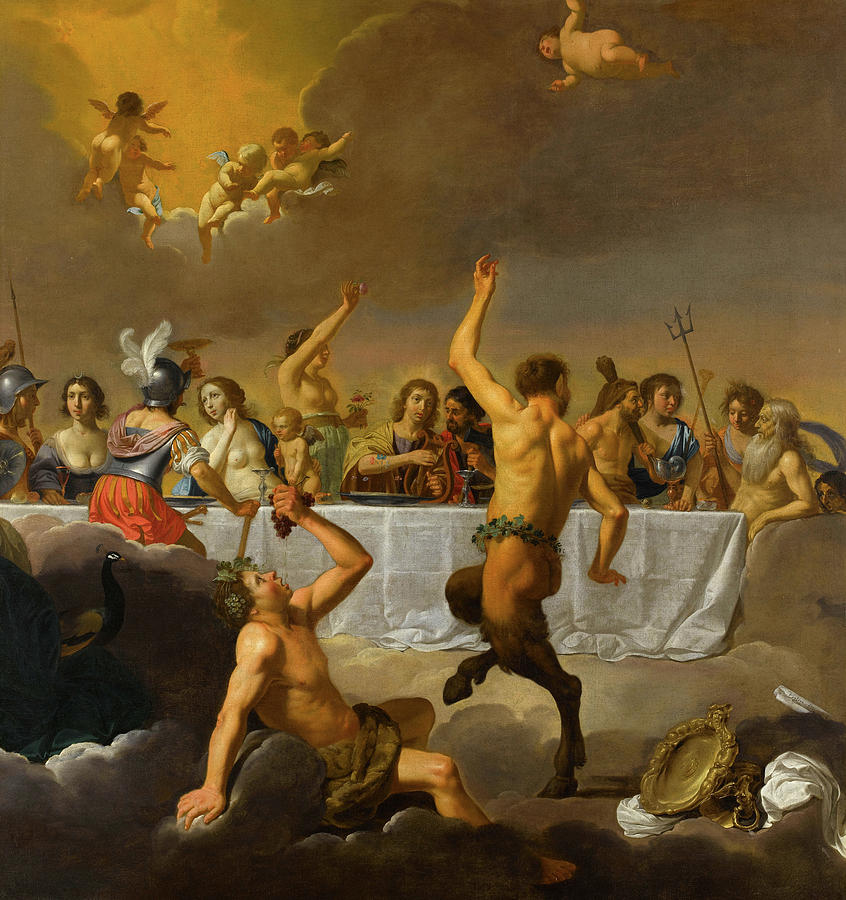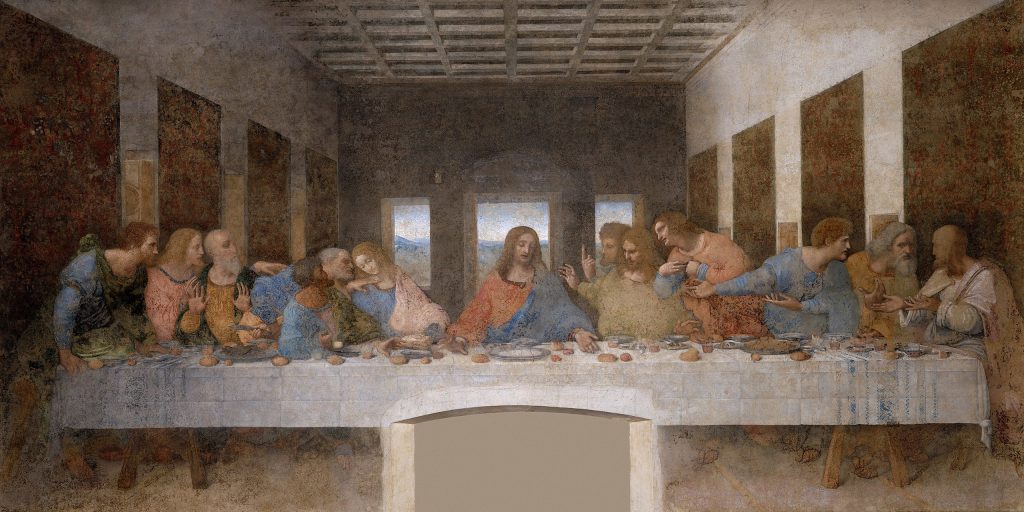Law & Politics
Controversy Erupts Over Paris Olympics Take on Leonardo’s ‘Last Supper’
The controversial scene at the opening ceremony actually more closely matches Jan Harmensz van Biljert's 'The Feast of the Gods.'

The controversial scene at the opening ceremony actually more closely matches Jan Harmensz van Biljert's 'The Feast of the Gods.'

Sarah Cascone

Organizers of the Paris Olympic Games have apologized for what appeared to be reenactment of Leonardo da Vinci’s The Last Supper at the opening ceremonies featuring a colorful cast of drag queens. But they insist the scene was actually meant to be an ancient Greek bacchanal—not a mockery of a key moment from the Christian religion.
“The idea was to create a big pagan party in link with the God of Mount Olympus,” opening ceremony director Thomas Jolly, told France’s BFMTV. “[The Last Supper is] not my inspiration and that should be pretty obvious.”
“My wish isn’t to be subversive, nor to mock or to shock. Most of all, I wanted to send a message of love, a message of inclusion and not at all to divide,” he added in an interview with the AP, noting that he had been bullied as a child for being gay.
The four-hour event saw athletes float along the River Seine in a unique take on the parade of nations, with performances along the route to the Eiffel Tower.
In this scene from the Olympic opening ceremony, the famous painting of The Last Supper is recreated, but Jesus is replaced with an obese woman, while queer and trans figures (including a child!) depict her apostles.
Overt pagan and satanic symbolism. pic.twitter.com/YImWfFDekB
— Jenna Ellis (@realJennaEllis) July 26, 2024
On the Passerelle Debilly bridge, a drag fashion show kicked off with the figures posing dramatically along one side of the raised catwalk, as if sitting at a long table. The central figure, DJ and producer Barbara Butch, was behind a turntable wearing an elaborate, rayed silver head piece that some viewers interpreted as a reference to Jesus with a halo.
“In this scene from the Olympic opening ceremony, the famous painting of The Last Supper is recreated, Jesus is replaced with an obese woman, while queer and trans figures (including a child!) depict her apostles,” Jenna Ellis, Donald Trump’s 2020 campaign attorney to, wrote on X, formerly Twitter.
“The idea of the central figure with a halo and a group of followers on either side—it’s so typical of The Last Supper iconography that to read it in any other way might be a little foolhardy,” art historian Sasha Grishin, of Australian National University, told the New York Times.
But social media users suggested that Butch wasn’t meant to be Jesus, but the French Lady Liberty, also known as Marianne, a symbol of the nation. There were also at least 17 Olympic performers, compared to the 12 apostles in The Last Supper, with poses that recalled voguing more than the clustered groupings of three men in the Leonardo fresco.

Leonardo da Vinci, The Last Supper (1495–98). Santa Maria delle Grazie Church, Milan. Public domain/Creative Commons Attribution-Share Alike 4.0 International license.
And The Last Supper doesn’t have obvious ties to French culture, which was heavily referenced during the opening ceremonies. Leonardo’s other most famous work, the Mona Lisa, is of course housed at the Louvre. The painting had a fun cameo in the festivities, when it was stolen by Despicable Me henchmen the Minions.
There is, however, a notable Old Master work that does call France home that seems a closer match to the controversial Olympic tableaux. That’s Jan Harmensz van Biljert’s The Feast of the Gods, a 1635 Dutch painting from the collection of the Magnin Museum, in Dijon, eastern France.
In that work, the gods are sitting at a long table, with Apollo, the sun god, at the center. There is also a child at the meal, matching the child in the Olympic performance that angered some viewers.
“Does this painting remind you of something?” the museum wrote on X after the ceremony’s conclusion. (The similarities were also pointed out by a handful of social media users with deep art historical knowledge.)
The world is a stage, and Paris is a catwalk. 💅
The #OpeningCeremony is France’s largest nightclub. Celebrities are showcasing young French designer talent, while DJ Barbara Butch provides the tunes. The perfect moment for the last delegations to arrive. ✨ #Paris2024 pic.twitter.com/zOzELw8n8a
— The Olympic Games (@Olympics) July 26, 2024
The bacchanalian nature of the opening ceremonies scene became more explicit when the drag queens were joined by French actor Philippe Katerine. He was playing the role of the Greek deity Dionysus, god of wine—for which France is well known—and festivity, and father of Sequana, the goddess of the Seine river.
Skin painted bright blue and nearly nude, he was revealed beneath a giant silver cloche surrounded by fruit like the main course of the feast. In all, it was a tribute to French joie de vivre, as well as the nation’s reputation for gastronomic excellence.
The official Olympics social media account shared a photo of the scene, noting that the “interpretation of the Greek God Dionysus makes us aware of the absurdity of violence between human beings.”
The interpretation of the Greek God Dionysus makes us aware of the absurdity of violence between human beings. #Paris2024 #OpeningCeremony pic.twitter.com/FBlQNNUmvV
— The Olympic Games (@Olympics) July 26, 2024
“We wanted to include everyone, as simple as that,” Jolly said at a press conference following the event. “In France, we have freedom of creation, artistic freedom. We are lucky in France to live in a free country. I didn’t have any specific messages that I wanted to deliver. In France, we are republic, we have the right to love whom we want, we have the right not to be worshippers, we have a lot of rights in France, and this is what I wanted to convey.”
Nevertheless, the outrage from conservative voices on social media was immediate, calling the performance blasphemous and even satanic.
Official statements from various religious groups followed. The French Catholic Church’s conference of bishops “deplored a ceremony that included scenes of derision and mockery of Christianity.”
And politicians also chimed in, with Mike Johnson, speaker of the U.S. House of Representatives, calling the performance “shocking and insulting to Christian people around the world,” on X.
“Opening the Olympics by insulting billions of Christians around the world was a really bad start, dear French,” Matteo Salvini, the leader of Italy’s far-right League party and the nation’s deputy prime minister, added.

A drag queen fashion show on the Passerelle Debilly bridge along the Seine river during the opening ceremony of the Paris 2024 Olympic Games in Paris on July 26, 2024, sparked controversy for its similarity to Leonardo da Vinci’s The Last Supper. Photo by Mauro Pimentel/AFP via Getty Images.
In response, the Olympic organizers did issue an apology.
“Clearly there was never an intention to show disrespect to any religious group. On the contrary, I think (with) Thomas Jolly, we really did try to celebrate community tolerance,” Paris 2024 spokesperson Anne Descamps said during an International Olympic Committee news conference. “If people have taken any offense we are, of course, really, really sorry.”
However, event producers also issued a statement to the Wrap contradicting Jolly’s denials.
“For the ‘Festivities’ segment, Thomas Jolly took inspiration from Leonardo da Vinci’s famous painting to create the setting,” producers told the. “Clearly, there was never an intention to show disrespect towards any religious group or belief… [Jolly] is not the first artist to make a reference to what is a world-famous work of art. From Andy Warhol to The Simpsons, many have done it before him.”